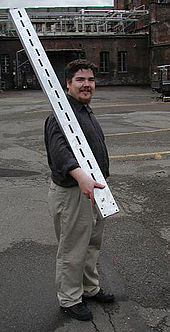Slot antenna
A slot antenna is a special type of antenna that follows a principle that is unusual for antenna construction: Antennas are usually constructed in such a way that a metallic structure in space is surrounded by air (as a non-conductor) and thus radiates the waves. The slot radiator, on the other hand, is an interruption in a metallic structure (e.g. a metal plate, a waveguide , etc.) that ensures the radiation of waves. Often this interruption follows the principle of the dipole , but can theoretically have any other geometry. Heinrich Bosse registered a patent for the slot antenna at C. Lorenz in 1951 .
construction
A dipole consists of a conductor in a dielectric , usually air. In the opposite case, the shape of this conductor can also be cut into a surface conductor as a negative. In the field geometry, the H field and E field are interchanged : while the rod antenna creates an electric dipole, a slot antenna of the same geometry radiates as a magnetic dipole. Since the two fields are proportional to each other in the far field, the antenna diagram is the same . At the feed point, current and voltage are exchanged; for the radiation resistances and complementary antennas applies (also apart from the resonance):
This is the wave resistance of the vacuum .
Applications
Slot antennas are mainly used for high frequencies , usually above 1 GHz. The feed points and conditions correspond to those of normal dipole antennas . Slot antennas are particularly suitable in aircraft construction because they do not protrude beyond the outer shell of an aircraft. In the area of radar systems , especially on ships, slot antennas are designed directly as a rotating unit. The horizontally and rotatably mounted waveguide has several slots, the spacing and size of which depend on the frequency and the directional effect of the antennas to be achieved . In this design, the antenna is called a slot group antenna, which belongs to the group of directional antennas . The antenna gain is less than with a parabolic antenna, but the production of a slot group antenna is cheaper.
With slot group antennas, several slots are fed by a waveguide , in the wall of which they are milled. Each individual slot represents a radiator, and the directional effect is achieved by superimposing the emitted waves in the outside area. Slits at a distance of half the wavelength in the waveguide result in vertical radiation from the array. An antenna for 2.4 GHz can be seen on the right in the picture. With a free space wavelength of a good 12 cm, an antenna with 16 elements reaches a radiating length of around 1.5 m. The antenna gain from an array with 16 radiators is 12 to 14 dBd. The slots must be offset so far from the center (where they would be ineffective) that they decouple an appropriate proportion of the field spreading in the waveguide.
See also
literature
- Alois Krischke: Rothammels Antennenbuch. 11th edition, Franckh-Kosmos-Verlags-GmbH, Stuttgart 1995, ISBN 3-440-07018-2
- Heinrich Bosse: Theoretical and experimental investigation of the tubular slot antenna. Dissertation, TU Braunschweig, 1951





